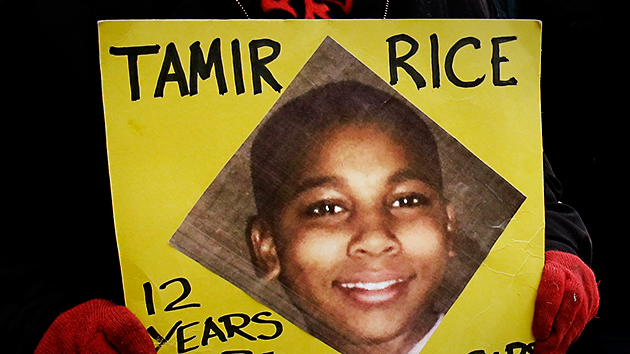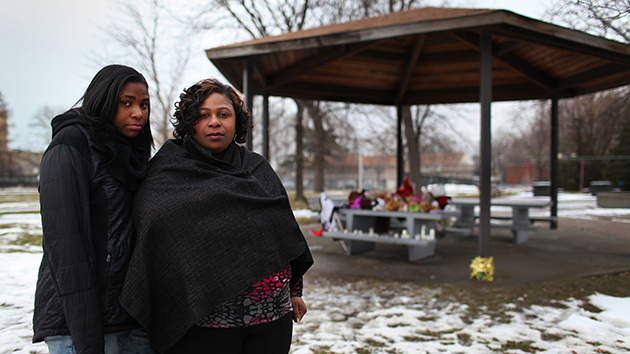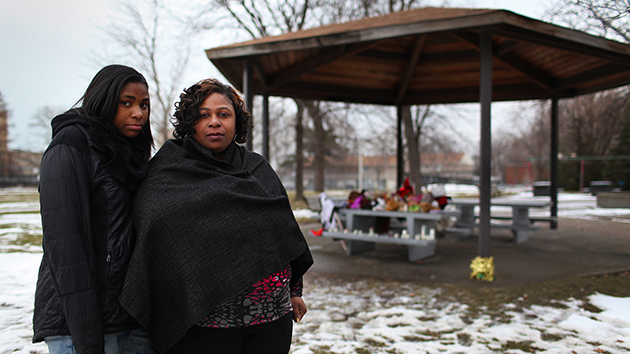
Tony Dejak/AP
Update (3:08 p.m. ET, 12/28/2015): The family of Tamir Rice has issued the following statement:
Here’s the response from #TamirRice‘s family: pic.twitter.com/1aCUSja0QT
— Jaeah J. Lee (@jaeahjlee) December 28, 2015
On Monday, more than a year since 12-year-old Tamir Rice was killed by a Cleveland police officer, a grand jury decided not to indict the cops involved, Timothy Loehmann and Frank Garmback. Cuyahoga County Prosecutor Timothy McGinty said that despite “the perfect storm” of errors that day, those errors “did not constitute criminal conduct.”
On the afternoon of November 22, 2014, less than 10 minutes after a man called 911 to report a person in a park waving around what appeared to be a gun, Loehmann and his partner Garmback drove up directly in front of Rice, with Loehmann emerging from the patrol car and shooting the boy almost instantaneously. Surveillance footage showed the officers standing around for several minutes after the shooting without giving Rice, any kind of first aid or tending to his wounds. The boy died at a hospital the next day. The gun in Rice’s possession turned out to be a toy replica.
Monday’s decision emerges after more than a year of public controversy and investigations into the incident, first by the Cleveland police department and then by the Cuyahoga County sheriff’s office, which in July handed over its findings to McGinty. Beginning in October, McGinty released three independent reports assessing the legality of Loehmann’s and Garmback’s actions. The reports, written by experts tapped by the prosecutor, all appeared to absolve the officers of misconduct. Their release to the public long before the grand jury decision was unusual—grand jury proceedings are typically closed off to the public—and the move prompted Rice’s family and supporters to call for a special prosecutor to take over the case. Neither Loehmann nor Garmback ever spoke to investigators, as Mother Jones first reported in May, but in December the two officers released public statements for the first time since Rice’s death.
Here are the key events that led up to the grand jury decision:
November 22, 2014: A 911 caller tells a police dispatcher that a man who is “probably a juvenile” is waving around a gun that is “probably fake.” The call taker fails to relay those details in the dispatch computer system and codes the call a “priority 1.” A radio dispatcher requests officers to the scene. Tamir Rice is shot and killed within 10 minutes of the 911 call.
December 3, 2014: A report from the Cleveland Plain Dealer reveals that Loehmann’s personnel record showed the officer had a troubling history with handling guns in the past. According to reports by supervisors at the Independence Police Department—where Loehmann served a six-month stint in 2012 before joining the Cleveland police—he was “distracted” and “weepy” during firearms qualifications training. An Independence deputy police chief wrote that Loehmann “could not follow simple directions, could not communicate clear thoughts nor recollections, and his handgun performance was dismal,” and recommended that the department part ways with him.
December 5, 2014: Rice’s family files a federal wrongful death suit against Loehmann, Garmback, and the city of Cleveland.
January 2015: The Cuyahoga County sheriff’s office takes over the city’s investigation into the shooting.
June 11, 2015: A Cleveland judge finds there is sufficient evidence to charge both Loehmann and Garmback, but leaves that decision up to the county prosecutor.
June 13, 2015: After five months, the county sheriff’s office releases the results of its probe. Loehmann and Garmback, as Mother Jones was the first to report, refused to speak with investigators despite multiple requests by investigators to interview them.
October 11, 2015: Cuyahoga County Prosecutor McGinty releases two reports that conclude Loehmann’s actions were “objectively reasonable” and constitutional, suggesting the investigation may not lead to charges. The two reports note that possible tactical errors made by the officers—such as whether Loehmann issued a warning before firing shots—are not relevant to the findings. The release of the reports stirs a public outcry and prompts Rice’s family and supporters to call for McGinty’s recusal from the grand jury process and for a special prosecutor to take over the case.
November 12, 2015: McGinty releases a third report that focuses on the potential mishandling of the 911 call and whether Garmback’s decision to drive the squad car to within feet of Rice contributed to the shooting. The report concludes that the 911 dispatcher and both officers’ actions were reasonable.
November 28, 2015: Two outside law enforcement experts, retained by the Rice family’s attorneys, conclude in their reports that Loehmann’s and Garmback’s actions were “reckless” and unjustifiable under the law. They challenge the three earlier reports released by the county prosecutor.
December 1, 2015: After a yearlong silence, Loehmann and Garmback release their written accounts of what happened on the day of the shooting. Their statements are made public through the county prosecutor. “I had very little time as I exited the vehicle,” Loehmann wrote of the moments before he fired two shots at Rice. “We are trained to get out of the cruiser because ‘the cruiser is a coffin.'” He added, “I saw the weapon in his hands coming out of his waistband and the threat to my partner and myself was real and active.”
December 15, 2015: Rice’s family formally requests a Department of Justice investigation into the boy’s death and the prosecutor’s handling of the grand jury proceedings.






